Contents
- 1. Users Manual 1
- 2. Users Manual 2
- 3. Users Manual 3
- 4. Users Manual 4
Users Manual 1

T
Fixed Network
Repeater
Installation Guide
D R A F T
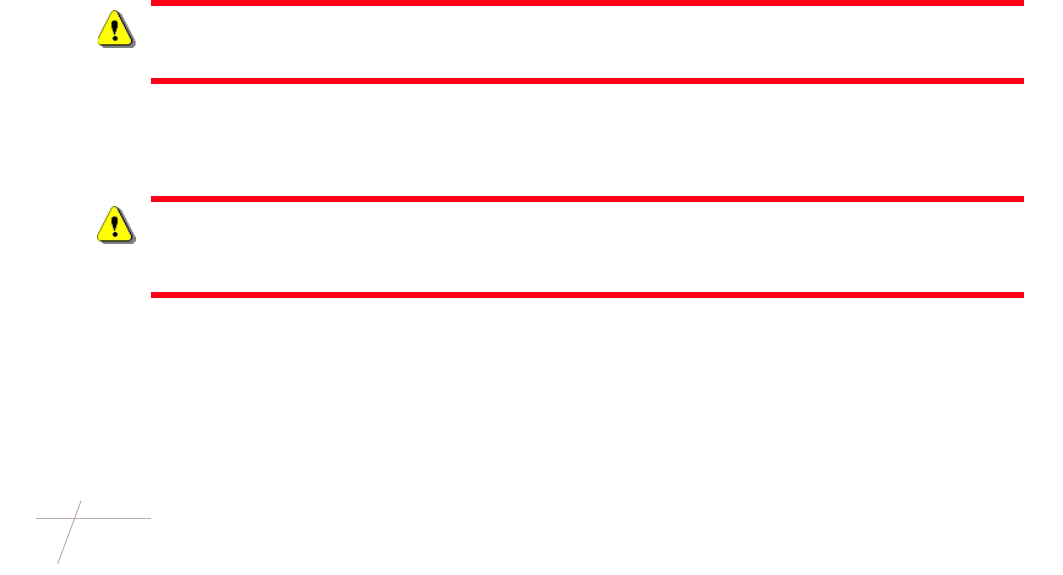
ii Fixed Network Repeater Installation Guide
TDC-0613-000 10/04
DRAFT
Identification
Fixed Network Repeater Installation Guide
TDC-0613-000 10/04
Trademark Notice
Itron is a registered trademark of Itron, Inc.
All other product names and logos in this document are used for identification purposes only and may be trademarks or registered
trademarks of their respective companies.
Copyright Notice
Your company has the right to reproduce this contract document provided that such reproduction shall be subject to the same use
and disclosure restrictions contained in the Confidentiality and Non-Disclosure paragraphs in the Sales Contract.
© 2004 Itron, Inc. All rights reserved.
Compliance Statement
This equipment has been tested and found to comply with the limits for a Class B digital device, pursuant to Part 15 of the FCC
Rules. These limits are designed to provide reasonable protection against harmful interference in a residential installation. This
equipment generates, uses, and can radiate radio frequency energy and, if not installed and used in accordance with the
instructions, may cause harmful interference to radio communications. However, there is no guarantee that interference will not
occur in a particular installation.
If this equipment does cause harmful interference to radio or television reception, which can be determined by turning the
equipment off and on, the user is encouraged to try to correct the interference by one or more of the following measures:
• Reorient or relocate the receiving antenna.
• Increase the separation between the equipment and receiver.
• Connect the equipment into an outlet on a circuit different from that to which the receiver is connected.
• Consult the dealer or an experienced radio or TV technician for help.
This device complies with Subpart C of Part 15 of FCC Rules. Operation of this device is subject to the following two conditions:
• This device may not cause harmful interference.
• This device must accept any interference that may cause undesirable operation.
This device complies with Part 15.247 of the FCC rules governing spread spectrum devices. The device operates in the 900 MHz
unlicensed band at a maximum peak power level of 1 watt with a transmission duration that will not exceed 50 milliseconds.
This device must be permanently mounted such that it retains a distance of 20 centimeters (7.9 inches) from all persons in order
to comply with FCC RF exposure levels.
Modification and Repairs
To ensure FCC compliance and system performance, this device, antenna and coaxial assembly shall not be changed or modified
without the expressed approval of Itron. Any modification may void the user’s authority to operate the equipment.
Meter Installation/Removal
In the event of malfunction, all repairs should be performed by Itron. It is the responsibility of users requiring service to report
the need for service to Itron.
Customer Service
If you have questions, comments or suggestions contact Itron as follows:
• Mail: Itron, Inc.; Attention: Customer Care; 2818 N. Sullivan Road; Spokane, WA 99216
• E-mail: support@itron.com
• Phone: 1-800-635-8725
WARNING! This device contains no user servicable parts. Attempts to repair this device by unauthorized personnel may
subject the person to shock hazard if removal of protective covers is attempted. Unauthorized repair may void the warranty
and/or maintenance contract with your company.
WARNING! The installation of this device may subject the installer to hazardous conditions, including the possibility of
electrical shock. Trained professionals should install this device. This instruction manual should be considered supple-
mental and used in addition to and in accordance with your company’s meter installation and removal procedures and all
related safety regulations.

DRAFT
Contents iii
TDC-0613-000 10/04
Contents
List of Procedures. . . . . . . . . . . . . . . . . . . . . . . . . . . . . . . . . . . . . . . . . . . v
Before You Begin . . . . . . . . . . . . . . . . . . . . . . . . . . . . . . . . . . . . . . . . . . vii
Overview . . . . . . . . . . . . . . . . . . . . . . . . . . . . . . . . . . . . . . . . . . . . . . vii
Audience . . . . . . . . . . . . . . . . . . . . . . . . . . . . . . . . . . . . . . . . . . . . . . vii
How This Document is Organized . . . . . . . . . . . . . . . . . . . . . . . . . . . vii
Documentation Conventions . . . . . . . . . . . . . . . . . . . . . . . . . . . . . . . vii
Chapter 1 Getting Started. . . . . . . . . . . . . . . . . . . . . . . . . . . . . . . . . . . . . . . . . . . . . . 1
What is a Repeater? . . . . . . . . . . . . . . . . . . . . . . . . . . . . . . . . . . . . . . . . . . 1
Overview . . . . . . . . . . . . . . . . . . . . . . . . . . . . . . . . . . . . . . . . . . . . . . . 1
Repeater Identification . . . . . . . . . . . . . . . . . . . . . . . . . . . . . . . . . . . . . 1
Repeater Configuration . . . . . . . . . . . . . . . . . . . . . . . . . . . . . . . . . . . . 1
Repeater Types . . . . . . . . . . . . . . . . . . . . . . . . . . . . . . . . . . . . . . . . . . 1
Repeater Specifications . . . . . . . . . . . . . . . . . . . . . . . . . . . . . . . . . . . . 1
Planning for Repeater Installations . . . . . . . . . . . . . . . . . . . . . . . . . . . . . . . 2
Installation Types . . . . . . . . . . . . . . . . . . . . . . . . . . . . . . . . . . . . . . . . . 2
Unpacking the Repeater . . . . . . . . . . . . . . . . . . . . . . . . . . . . . . . . . . . . . . . 3
Overview . . . . . . . . . . . . . . . . . . . . . . . . . . . . . . . . . . . . . . . . . . . . . . . 3
Pole-Mount Repeater . . . . . . . . . . . . . . . . . . . . . . . . . . . . . . . . . . . . . . 3
Sleeve-Mount Repeater . . . . . . . . . . . . . . . . . . . . . . . . . . . . . . . . . . . . 3
Chapter 2 Repeater Installation. . . . . . . . . . . . . . . . . . . . . . . . . . . . . . . . . . . . . . . . . 5
Getting Started . . . . . . . . . . . . . . . . . . . . . . . . . . . . . . . . . . . . . . . . . . . . . . 5
Overview . . . . . . . . . . . . . . . . . . . . . . . . . . . . . . . . . . . . . . . . . . . . . . . 5
Installing on a Street Light . . . . . . . . . . . . . . . . . . . . . . . . . . . . . . . . . . . . . . 5
Overview . . . . . . . . . . . . . . . . . . . . . . . . . . . . . . . . . . . . . . . . . . . . . . . 5
Required Hardware and Tools . . . . . . . . . . . . . . . . . . . . . . . . . . . . . . . 5
Earth Grounding. . . . . . . . . . . . . . . . . . . . . . . . . . . . . . . . . . . . . . . . . . 5
Wind Load . . . . . . . . . . . . . . . . . . . . . . . . . . . . . . . . . . . . . . . . . . . . . . 5
Installing on a Davit Using Standard Brackets . . . . . . . . . . . . . . . . . . . 6
Sleeve-Mount Repeaters. . . . . . . . . . . . . . . . . . . . . . . . . . . . . . . . . . . . . . . 9
Types of Sleeve- Mount . . . . . . . . . . . . . . . . . . . . . . . . . . . . . . . . . . . . 9
Required Tools . . . . . . . . . . . . . . . . . . . . . . . . . . . . . . . . . . . . . . . . . . . 9
Installing on a Ringless Meter Socket . . . . . . . . . . . . . . . . . . . . . . . . . 9
Installing on a Ringed Meter Socket. . . . . . . . . . . . . . . . . . . . . . . . . . 12
Chapter 3 Repeater Configuration . . . . . . . . . . . . . . . . . . . . . . . . . . . . . . . . . . . . . 15
Getting Started . . . . . . . . . . . . . . . . . . . . . . . . . . . . . . . . . . . . . . . . . . . . . 15
Overview . . . . . . . . . . . . . . . . . . . . . . . . . . . . . . . . . . . . . . . . . . . . . . 15

DRAFT
iv Fixed Network Repeater Installation Guide
TDC-0613-000 10/04
Navigating in QuickTerminal. . . . . . . . . . . . . . . . . . . . . . . . . . . . . . . . 15
Installing QuickTerminal . . . . . . . . . . . . . . . . . . . . . . . . . . . . . . . . . . . . . . 16
Overview . . . . . . . . . . . . . . . . . . . . . . . . . . . . . . . . . . . . . . . . . . . . . . 16
Requirements. . . . . . . . . . . . . . . . . . . . . . . . . . . . . . . . . . . . . . . . . . . 16
Installing QuickTerminal. . . . . . . . . . . . . . . . . . . . . . . . . . . . . . . . . . . 16
Running QuickTerminal from CD . . . . . . . . . . . . . . . . . . . . . . . . . . . . 17
Launching QuickTerminal . . . . . . . . . . . . . . . . . . . . . . . . . . . . . . . . . 18
Communicating with a Repeater . . . . . . . . . . . . . . . . . . . . . . . . . . . . . . . . 18
Setting Communication Options. . . . . . . . . . . . . . . . . . . . . . . . . . . . . 18
Connecting to a Remote Repeater. . . . . . . . . . . . . . . . . . . . . . . . . . . 18
Ending a Communication Session . . . . . . . . . . . . . . . . . . . . . . . . . . . 19
Display Current Configuration . . . . . . . . . . . . . . . . . . . . . . . . . . . . . . 20
Setting Communication Mode . . . . . . . . . . . . . . . . . . . . . . . . . . . . . . . . . . 22
Overview . . . . . . . . . . . . . . . . . . . . . . . . . . . . . . . . . . . . . . . . . . . . . . 22
Using In-Band Transmitter Mode . . . . . . . . . . . . . . . . . . . . . . . . . . . . 22
Using Keep-Away Transmitter Mode . . . . . . . . . . . . . . . . . . . . . . . . . 22
Set Bubble-Up Period . . . . . . . . . . . . . . . . . . . . . . . . . . . . . . . . . . . . 22
Change Transmitter Power Setting . . . . . . . . . . . . . . . . . . . . . . . . . . 22
Enable/Disable Message Repeat. . . . . . . . . . . . . . . . . . . . . . . . . . . . 22
Enable Duplicate Filter. . . . . . . . . . . . . . . . . . . . . . . . . . . . . . . . . . . . 23
Configuring Receiver Radio . . . . . . . . . . . . . . . . . . . . . . . . . . . . . . . . . . . 23
Set Receiver Parameters . . . . . . . . . . . . . . . . . . . . . . . . . . . . . . . . . . 23
View Receiver Statistics. . . . . . . . . . . . . . . . . . . . . . . . . . . . . . . . . . . 23
Display Current Version . . . . . . . . . . . . . . . . . . . . . . . . . . . . . . . . . . . 24
Display Receiver Parameters. . . . . . . . . . . . . . . . . . . . . . . . . . . . . . . 24
Reset Receiver. . . . . . . . . . . . . . . . . . . . . . . . . . . . . . . . . . . . . . . . . . 24
Calibrate Receiver . . . . . . . . . . . . . . . . . . . . . . . . . . . . . . . . . . . . . . . 24

List of Procedures v
TDC-0613-000 10/04
DRAFT
List of Procedures
Calibrate Receiver . . . . . . . . . . . . . . . . . . . . . . . . . . . . . . . . . . . . . . . . . . . . . . . . 24
Change Transmitter Power Setting . . . . . . . . . . . . . . . . . . . . . . . . . . . . . . . . . . . 22
Connecting to a Remote Repeater. . . . . . . . . . . . . . . . . . . . . . . . . . . . . . . . . . . . 18
Display Current Configuration . . . . . . . . . . . . . . . . . . . . . . . . . . . . . . . . . . . . . . . 20
Display Current Version . . . . . . . . . . . . . . . . . . . . . . . . . . . . . . . . . . . . . . . . . . . . 24
Display Receiver Parameters . . . . . . . . . . . . . . . . . . . . . . . . . . . . . . . . . . . . . . . . 24
Enable Duplicate Filter . . . . . . . . . . . . . . . . . . . . . . . . . . . . . . . . . . . . . . . . . . . . . 23
Enable/Disable Message Repeat . . . . . . . . . . . . . . . . . . . . . . . . . . . . . . . . . . . . . 22
Ending a Communication Session . . . . . . . . . . . . . . . . . . . . . . . . . . . . . . . . . . . . 19
Installing on a Davit Using Standard Brackets . . . . . . . . . . . . . . . . . . . . . . . . . . . . 6
Installing on a Ringed Meter Socket. . . . . . . . . . . . . . . . . . . . . . . . . . . . . . . . . . . 12
Installing on a Ringless Meter Socket . . . . . . . . . . . . . . . . . . . . . . . . . . . . . . . . . . 9
Installing QuickTerminal . . . . . . . . . . . . . . . . . . . . . . . . . . . . . . . . . . . . . . . . . . . . 16
Launching QuickTerminal. . . . . . . . . . . . . . . . . . . . . . . . . . . . . . . . . . . . . . . . . . . 18
Reset Receiver . . . . . . . . . . . . . . . . . . . . . . . . . . . . . . . . . . . . . . . . . . . . . . . . . . . 24
Running QuickTerminal from CD . . . . . . . . . . . . . . . . . . . . . . . . . . . . . . . . . . . . . 17
Set Bubble-Up Period. . . . . . . . . . . . . . . . . . . . . . . . . . . . . . . . . . . . . . . . . . . . . . 22
Set Receiver Parameters . . . . . . . . . . . . . . . . . . . . . . . . . . . . . . . . . . . . . . . . . . . 23
Setting Communication Options . . . . . . . . . . . . . . . . . . . . . . . . . . . . . . . . . . . . . . 18
Using In-Band Transmitter Mode . . . . . . . . . . . . . . . . . . . . . . . . . . . . . . . . . . . . . 22
Using Keep-Away Transmitter Mode . . . . . . . . . . . . . . . . . . . . . . . . . . . . . . . . . . 22
View Receiver Statistics . . . . . . . . . . . . . . . . . . . . . . . . . . . . . . . . . . . . . . . . . . . . 23

DRAFT
vi Fixed Network Repeater Installation Guide
TDC-0613-000 10/04

Before You Begin
vii
TDC-0613-000 10/04
Before You Begin
Overview This document describes the installation and configuration of Fixed Network
repeaters. This document describes the different types of repeaters, installation
kits and accessories, the installation process, and how to configure repeaters if
needed in the field using the Repeater Programmer.
Audience This document is intended for utility field personnel and others associated with
the installation and maintenance of a Fixed Network repeater. Installers should
have previous training and experience in the following:
• Installation and maintenance of electric meters
• Electrical wiring and related skills
• All utility-specific OSHA regulations and procedures
How This Document
is Organized This document is organized as the following.
Documentation
Conventions This document uses the following conventions.
Chapter Description
List of Procedures Provides an alphabetical list of all procedures con-
tained in this document.
Chapter 1.
Getting Started Describes what a repeater is, the types of repeaters,
specifications, and the contents of installation kits.
Chapter 2.
Repeater Installation Provides step-by-step instructions for installing
pole-mount or sleeve-mount repeaters.
Chapter 3. Repeater
Configuration Provides an overview and step-by-step instructions
for using the repeater programmer and QuickTer-
minal configuration application to configure
repeaters in the field.
Convention Example
Keypresses are in bold. Press Enter when complete.
Menu paths are in bold.From the Start menu, choose File > Save As.
(This example instructs the user to choose File
from the Start menu; then choose Save As from
the File menu.)
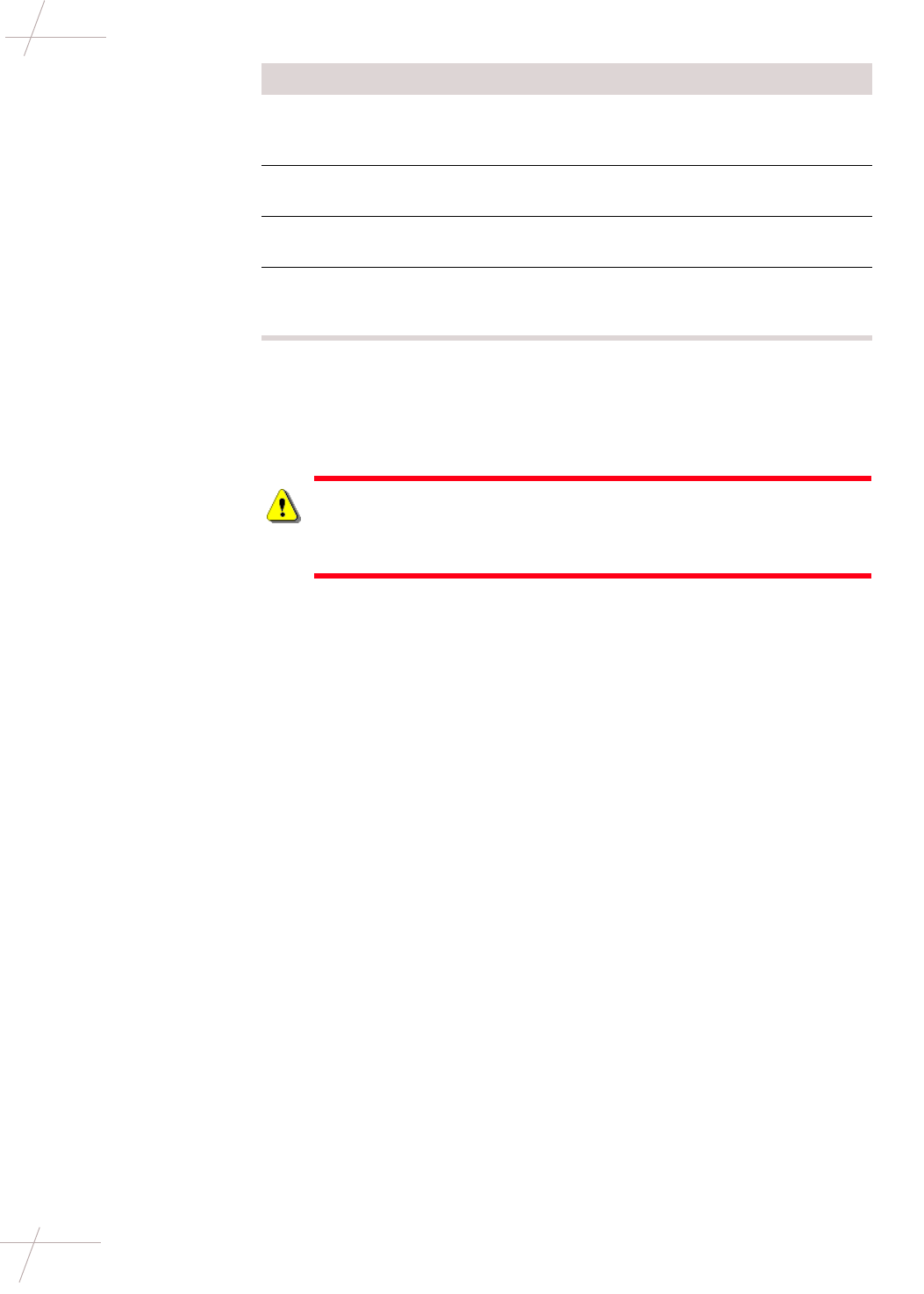
viii Fixed Network Repeater Installation Guide
TDC-0613-000 10/04
CAUTION This type of note warns the user that failure to heed the information in
the note could result in loss of data. Be sure to carefully read a CAUTION note
and heed the advice/instructions.
Computer commands to be
typed by the user are in
Courier New font.
At the C: prompt, type cd itron/bin
File names are in Courier
New font. The data is uploaded to the upload.dat file
Hypertext links are blue.See Contents on page iii for the complete table
of contents.
The last line in a table is
defined by a thick gray
line.
Note the thick gray line below this row. If the
table continues on another page, the column
headings are repeated on each page.
Convention Example
WARNING! This type of note is used to warn of potential physical harm
to the user or hardware. It is critical that you pay strict attention to
WARNING notes, read the information carefully, and heed the
advice/instructions.

DRAFT
Chapter 1 - Getting Started 1
TDC-0613-000 10/04
Chapter 1
Getting Started
What is a Repeater?
Overview The repeater is a network component that collects data from nearby ERT end-
points and forwards data to the Cell Control Unit (CCU), Itron's network col-
lector. A repeater expands the footprint of a CCU by forwarding data between
endpoints and CCU collectors. The repeater forwards both standard con-
sumption messages (SCM) and interval data messages (IDM).
The CCU, in turn, communicates the data to the Fixed Network Collection
Engine. The CCU opens communication sessions at regular intervals, listening
for data from the network repeaters. The CCU processes returned data according
to the default or custom parameters configured at the Collection Engine for each
meter. Repeaters communicate with ERT endpoints and the CCU in the 900
MHz radio band.
Repeater
Identification Each repeater has a unique identification number stored in its internal flash
memory. The ID number is used for remote unit communications, setting the
timing for acknowledgements, setting the index into the transmit, receiving hop
tables at power up, setting the random sequences in the transmit hop table, and
other functions. A repeater does not track other repeaters within its communi-
cation range.
Repeater
Configuration A repeater is configured at the factory prior to shipment. In certain cases, you
may use the Repeater Programmer to edit the configuration of a repeater to
optimize communication or to troubleshoot network problems. See Chapter 3,
Repeater Configuration on page 15 for more information.
Repeater Types Itron offers two types of repeaters: pole-mount and sleeve-mount. The type of
repeater you install will depend on your site characteristics and network needs.
Repeater
Specifications The following table lists the physical specifications for the pole-mount repeater.
Pole-Mount Repeater Specification Description
Power Source Single-phase 240V or 120V AC
Operating and Storage Temperature -40 to +75 C
Storage Temperature -40 to +85 C
Operating humidity 5 to 95% non-condensing relative
humidity

DRAFT
2 Fixed Network Repeater Installation Guide
TDC-0613-000 10/04
Planning for Repeater Installations
The following table lists specifications for the sleeve-mount repeater.
Planning for Repeater Installations
Installation Types A repeater may be installed in the field directly on a meter using a meter sleeve
or on a utility pole. The type of installation affects the radio performance of the
repeater. A pole mounted repeater will have a greater radio coverage area than a
sleeve mounted repeater. Select an installation type based on the following cri-
teria:
• Availability of utility poles
• Costs related to utility pole installation and future maintenance visits.
• Construction materials surrounding the selected meter installation site.
Product identification Numeric and bar coded repeater
module serial number
ANSI Compliance C12.1 standards
Receive/Transmit Frequency Range 908-924 MHz
Data Integrity Verified in every data message
Pole-Mount Repeater Specification Description
Sleeve-Mount Repeater Specification Description
Power Source Single-phase 240V or 120V AC
Operating and Storage Temperature -40 to +75 C
Storage Temperature -40 to +85 C
Operating humidity 5 to 95% non-condensing relative
humidity
Product identification Numeric and bar coded repeater
module serial number
ANSI Compliance C12.1 standards
Receive/Transmit Frequency Range 908-924 MHz
Data Integrity Verified in every data message
Meter Form Factor 2S 240V 3-wire Class 200
1S 120V 2-wire Class 100
Meter Sleeve Mount J4S, J5S

DRAFT
Chapter 1 - Getting Started 3
TDC-0613-000 10/04
Unpacking the Repeater
Unpacking the Repeater
Overview When you remove a repeater from its shipping carton, verify that no damage has
occurred during shipment. Return the repeater to its shipping packaging for
transport to the field. Transporting the repeater without protective packaging
may result in damage.
Pole-Mount
Repeater • Pole-mount repeater
•Antenna
• Antenna gasket
• Hex bolts (4)
• Washers (4)
• Lock washers (4)
• Photoelectric cell power adapter
Sleeve-Mount
Repeater • Sleeve-mount repeater
• Antenna cover and tension band
• Meter sealing ring

DRAFT
4 Fixed Network Repeater Installation Guide
TDC-0613-000 10/04
Unpacking the Repeater

DRAFT
Chapter 2 - Repeater Installation 5
TDC-0613-000 10/04
Chapter 2
Repeater Installation
Getting Started
Overview Your repeater installation process will depend on the type of repeater (pole-
mount or sleeve-mount) and the installation location.
Installing on a Street Light
Overview A pole-mount repeater mounts on a streetlight davit at least 6 inches behind the
lamp, which allows for clearance to change the light bulb in the lamp.
The mounting kit for the repeater will depend on the angle of the davit. If the
angle of the davit is less than 15 degrees, the standard bracket kit should be used.
If the angle is greater than 15 degrees, use the adjustable bracket kit.
Required Hardware
and Tools A pole-mount repeater installation requires the following tools and hardware:
• Mounting Kit (streetlight)
• 7/16-inch nut driver, wrench, or ratchet-wrench
• Inch-pound torque wrench with 7/16-inch socket
•1-inch wrench
• Tie wraps (not supplied with mounting kit)
Earth Grounding Depending on the local requirements for your utility company, you may need to
ground each repeater to earth ground. If you need to earth ground a repeater,
ground the case through one of the mounting screws that attach the repeater to
the pole using a grounding cable in accordance with local utility company guide-
lines. The grounding cable is not supplied by Itron.
Wind Load Prior to installing a repeater on a light pole, ensure that the weight and estimated
project area (EPA) of the repeater does not exceed the wind load and total weight
load of the light pole. The manufacturer of the light pole should provide wind
load and weight rating specifications.
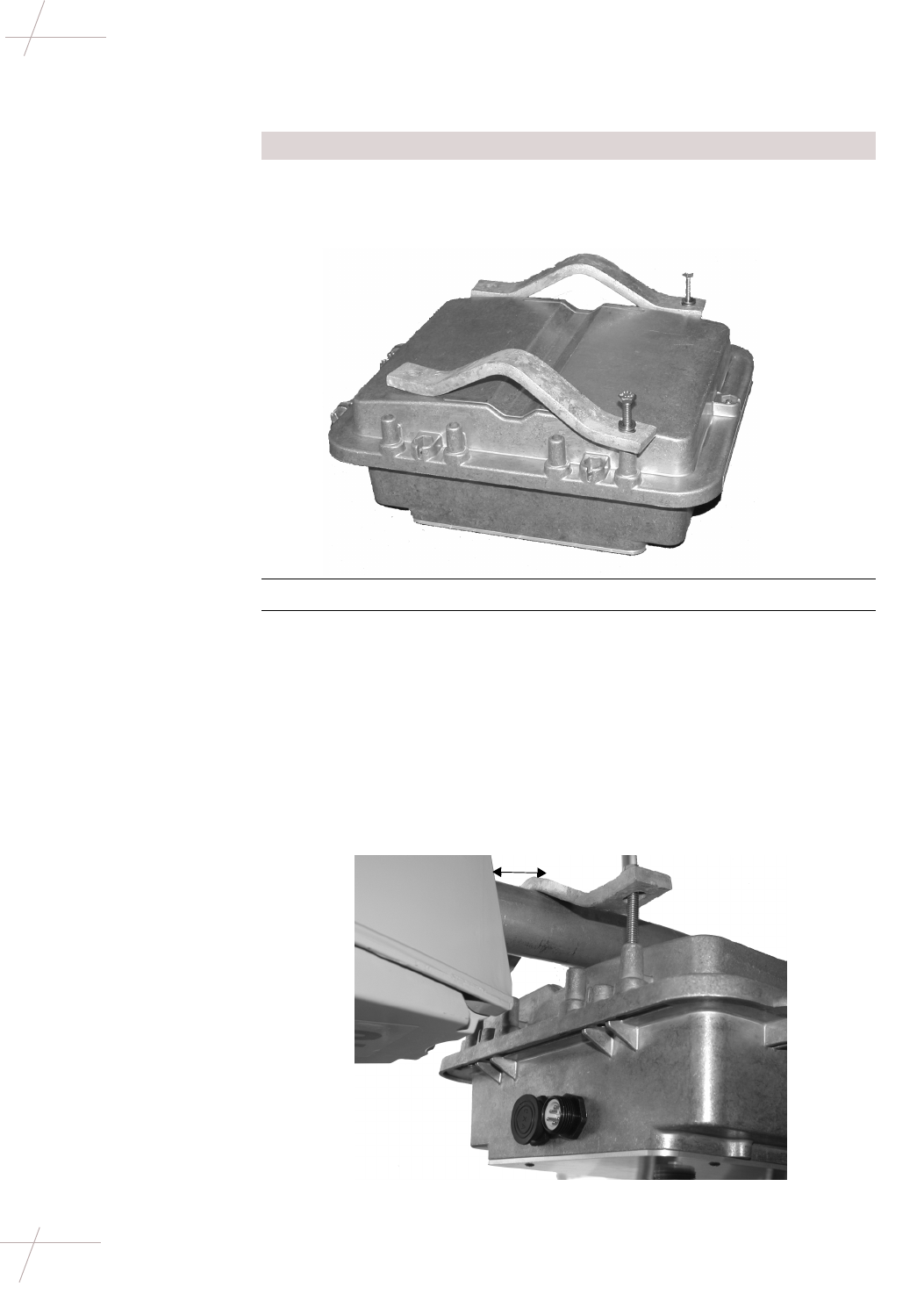
DRAFT
6 Fixed Network Repeater Installation Guide
TDC-0613-000 10/04
Installing on a Street Light
Installing on a Davit
Using Standard
Brackets
To install a repeater on a street light davit, do the following steps.
Step Action
1Partially bolt one end of each bracket onto the repeater, using the lock
washer and flat washer. Leave the bolts loose so that the bracket can
swing. When you are ready to install the repeater in the final position,
you will swing each bracket across the top of the davit and secure it.
2Place the antenna gasket over the antenna mount.
3Position the repeater beneath the davit, making sure that the repeater:
• Connectors face the street lamp
• Power cable can easily extend between the power connector at the
repeater and the photoelectric sensor
• Is placed is at least a 6 inches from the light fixture
• Mounting brackets are straight along the sides of the repeater lid
• Lid groove aligns with the davit
• Hangs straight down
6''
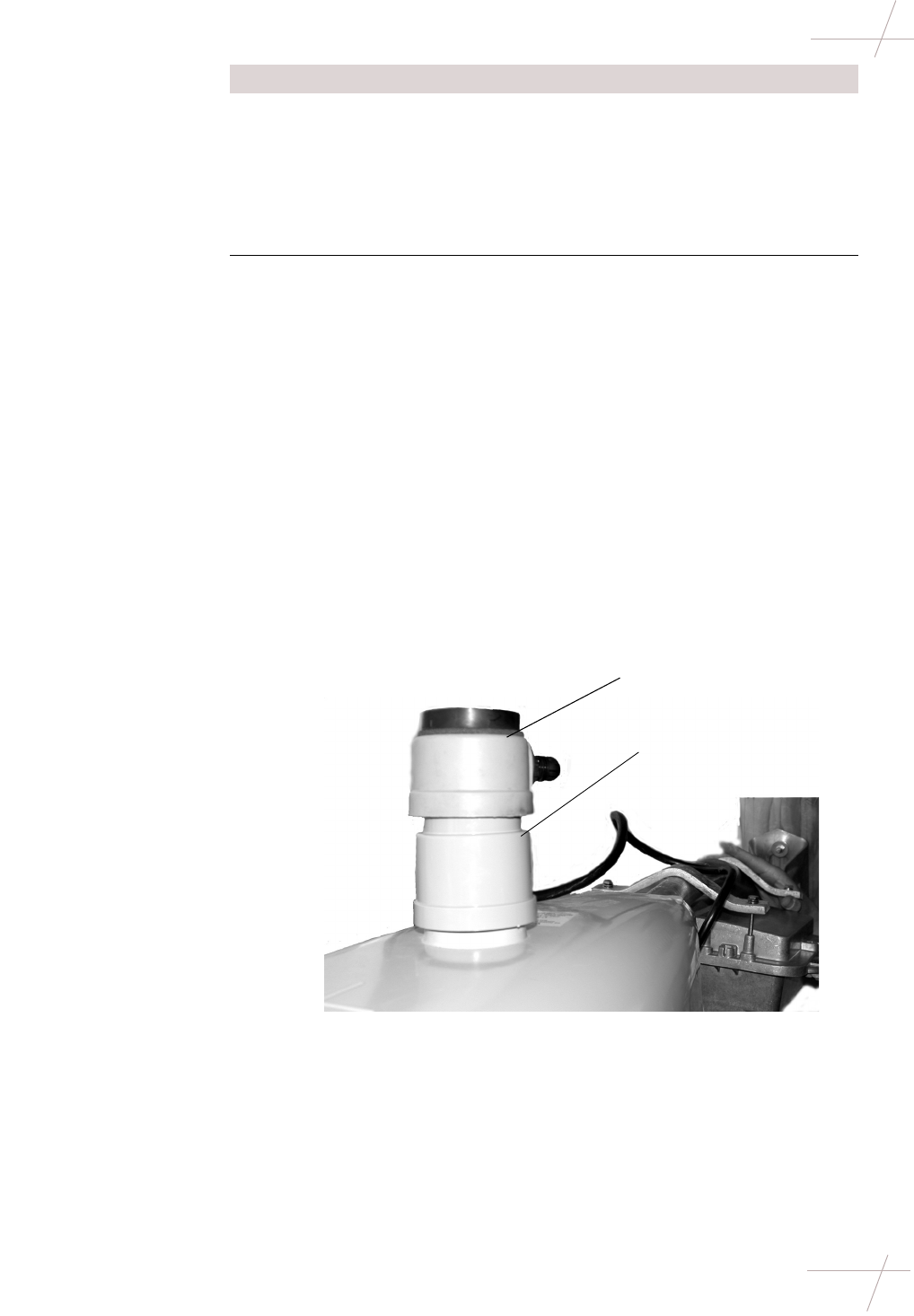
DRAFT
Chapter 2 - Repeater Installation 7
TDC-0613-000 10/04
Installing on a Street Light
4Swing the unsecured ends of the brackets over the davit and partially
bolt them, then torque the bolts to 40-inch pounds in a cross pattern.
IMPORTANT The four hex bolts must be torqued as specified to achieve
the clamping force needed to withstand 100 M.P.H. wind. If the bolts
are under-torqued, the necessary clamping force may not be obtained.
If the bolts are over-torqued, the brackets may become overstressed and
clamping force may be reduced.
5Install the photoelectric power adapter using the following steps:
a. Connect photoelectric power adapter to the 5-pin power connector
on the repeater.
b. Note the current orientation of the sensor window (usually it faces
north), so that you can restore it to that orientation when you are
done.
c. Remove the photoelectric sensor.
d. Insert the repeater photoelectric power adapter into the socket and
turn to lock it in place.
e. Re-insert the photoelectric sensor into the socket on the top of the
power adapter.
f. Adjust the adapter to face the photosensor window to its original
orientation by pulling up on the adapter housing and swiveling
the housing.
g. Use tie-wraps, as necessary, to secure the cable away from the
repeater housing.
Step Action
Photoelectric Power Adapter
Photoelectric Sensor
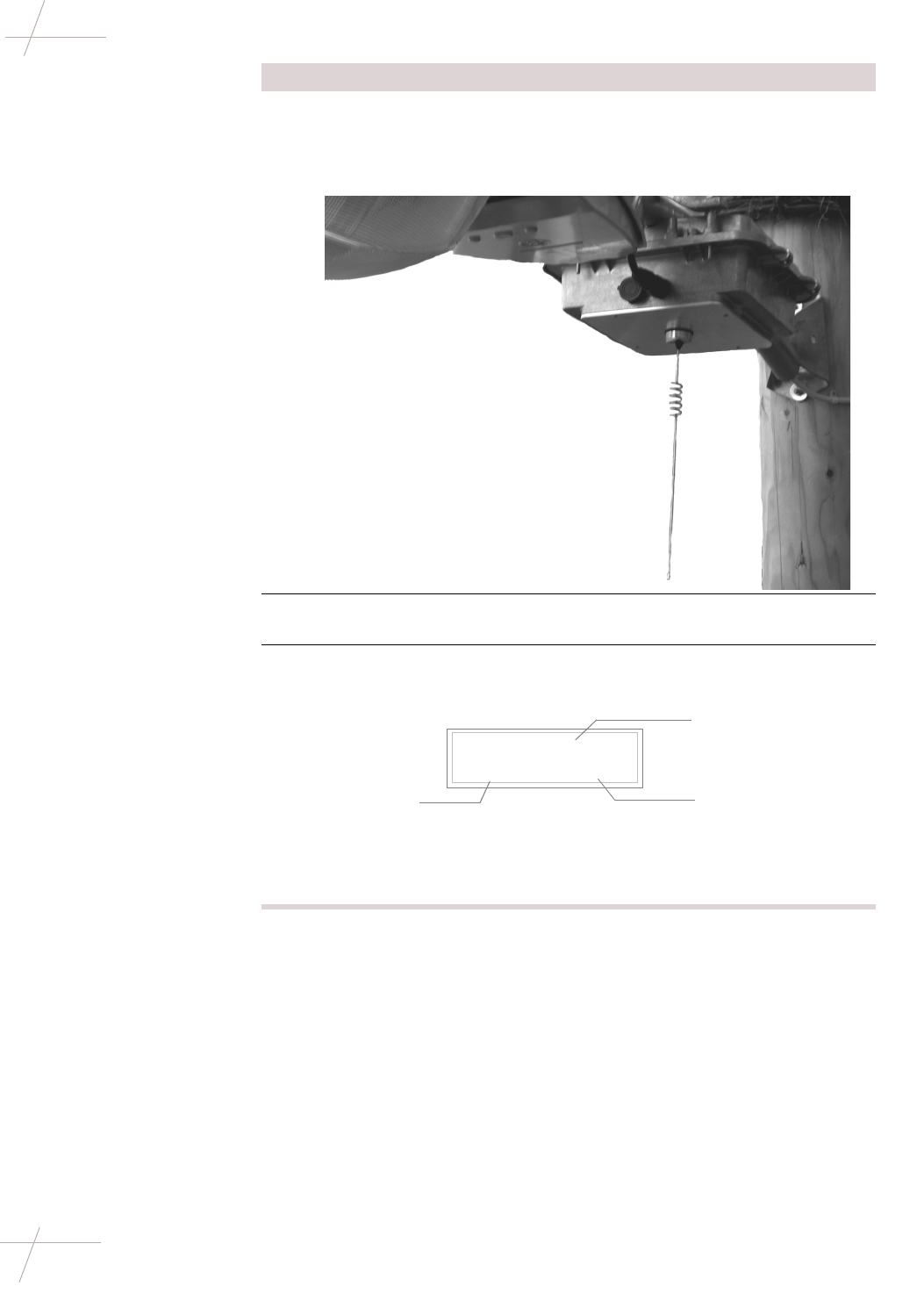
DRAFT
8 Fixed Network Repeater Installation Guide
TDC-0613-000 10/04
Installing on a Street Light
6Attach the antenna on the bottom of the repeater, tightening with a
wrench until the antenna makes contact.
TIP To test whether the antenna makes contact, try to wiggle the
antenna. If it seems loose, continue tightening.
7To verify a successful repeater installation, power on the Sentry 850
handheld.
8On the handheld, press Receive. If the repeater is correctly installed, the
repeated ERT readings will display on the handheld as illustrated
below.
NOTE The Sentry 850 reads all endpoints and repeaters within its
communication range and data may display rapidly. If needed, use the
Up and Down buttons to review entries for the repeated readings.
Step Action
TEPS + 12345678
4201 234
ID
Reading
1 indicates
a repeated read